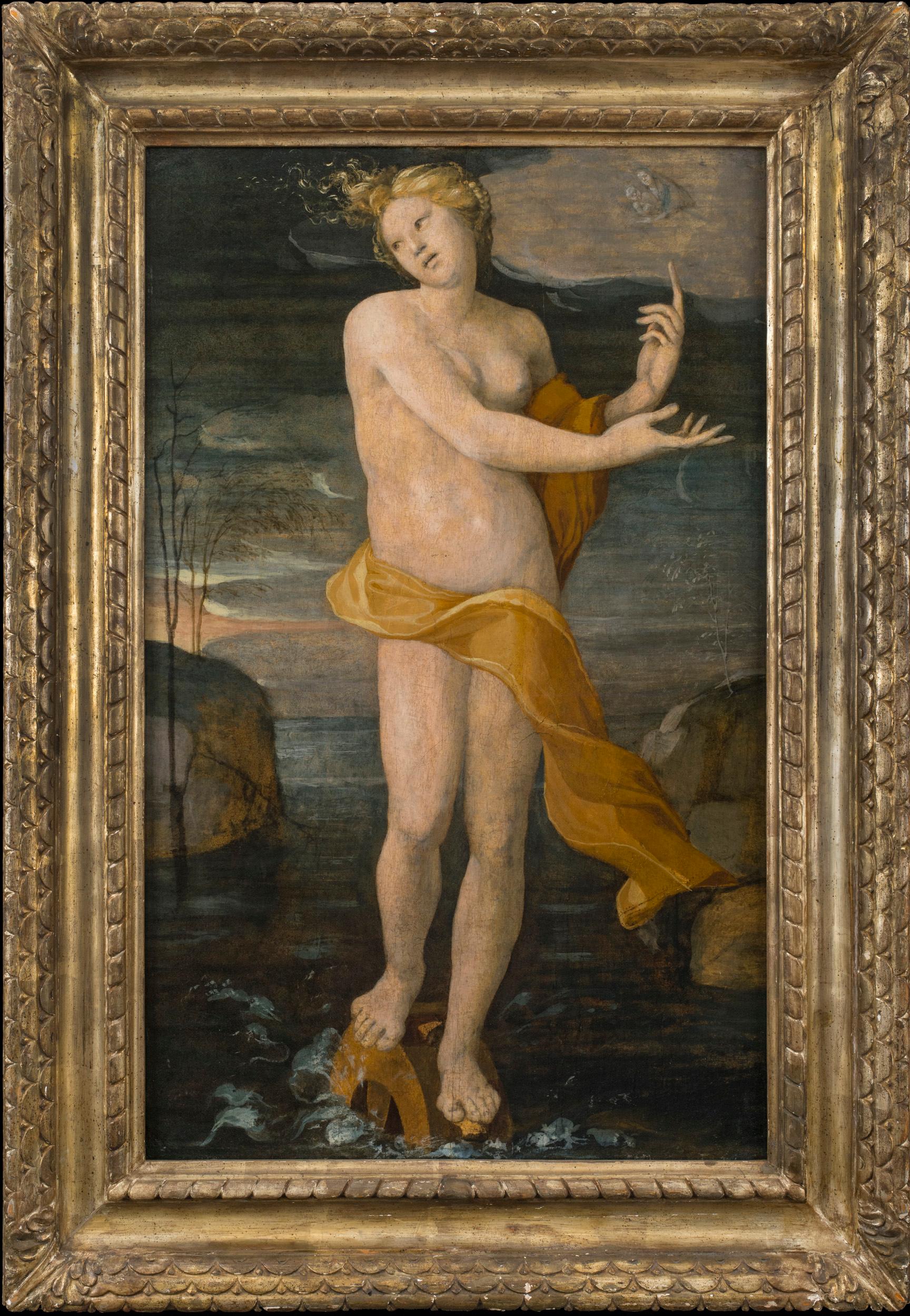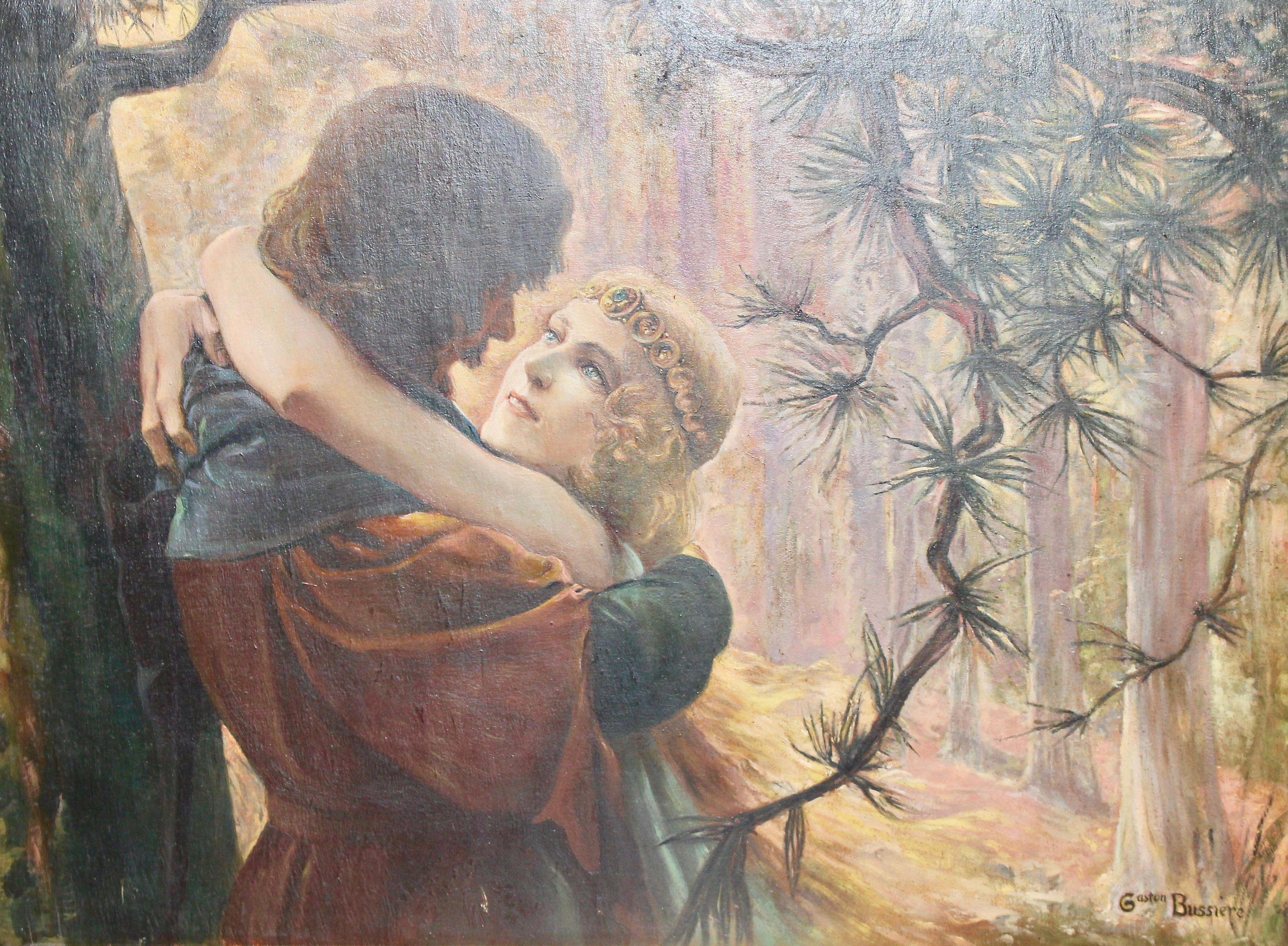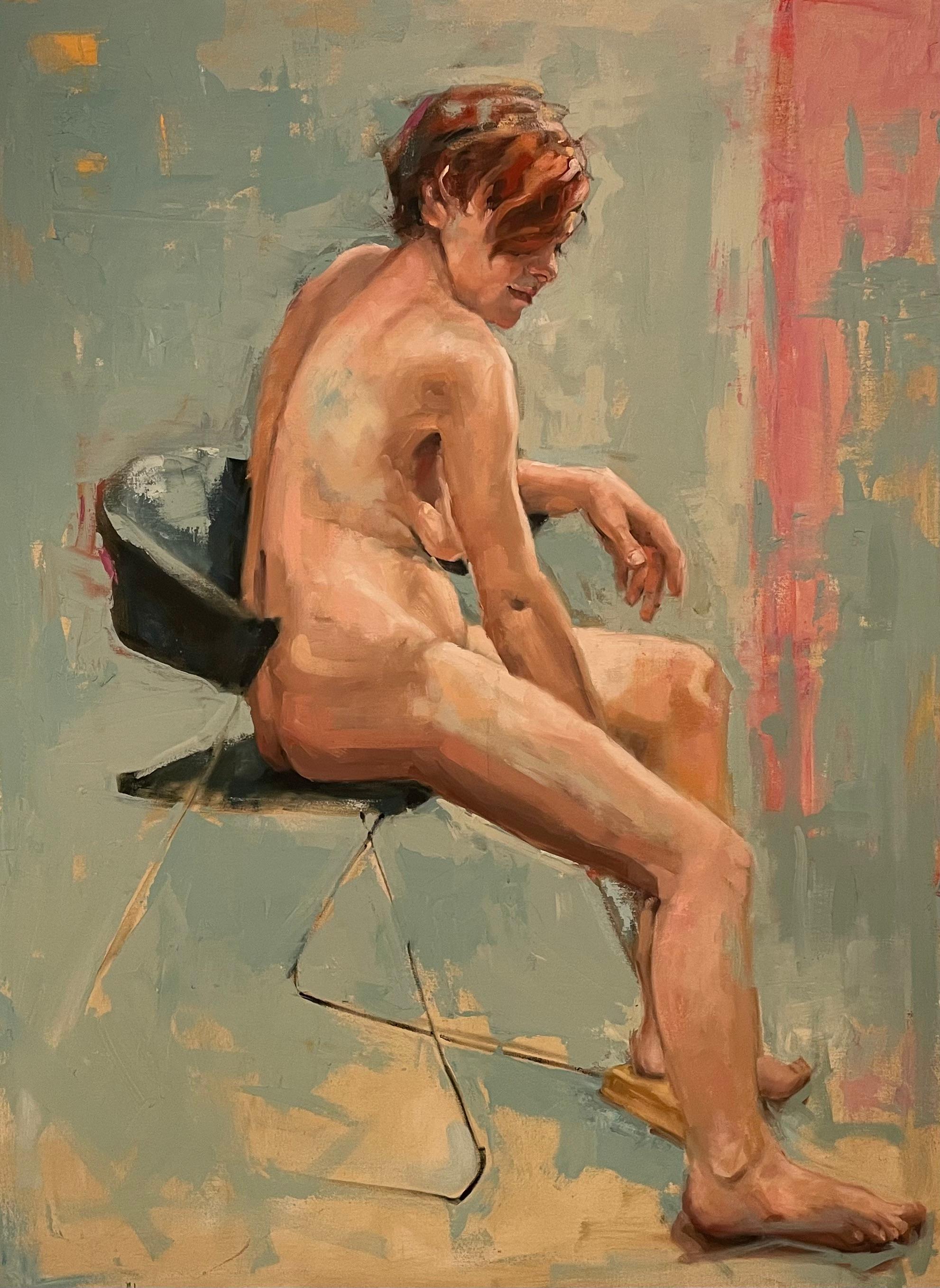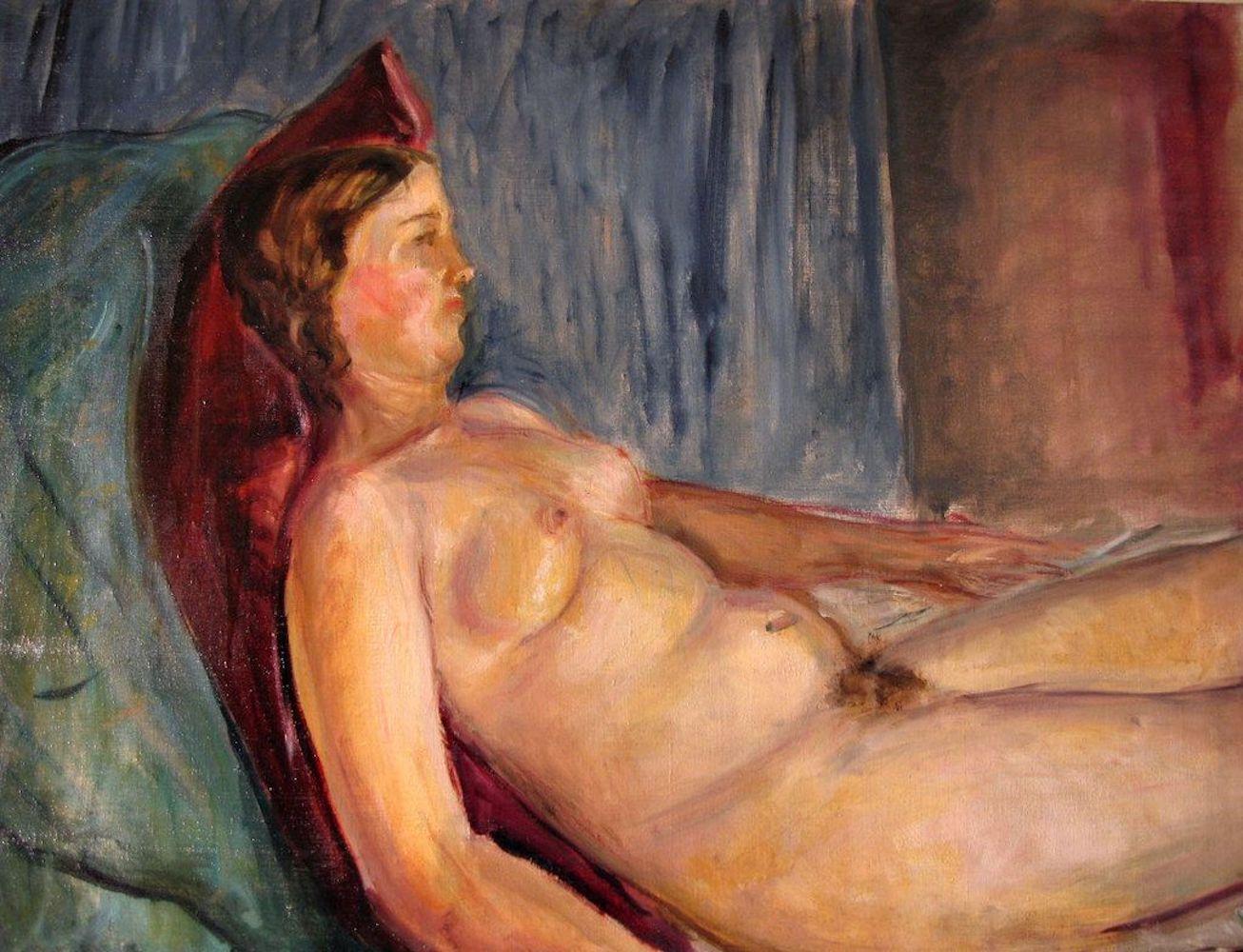Items Similar to Femme dan les sous-bois, 19th Century Adolphe MONTICELLI (1824-1886)
Want more images or videos?
Request additional images or videos from the seller
1 of 10
Femme dan les sous-bois, 19th Century Adolphe MONTICELLI (1824-1886)
About the Item
Femme dan les sous-bois, 19th Century
attributed to Adolphe MONTICELLI (1824-1886)
Large 19th Century French impressionist woodland scene of nude females, oil on canvas Adolphe Monticelli. Excellent quality and condition, labelled verso and presented in its original handmade gilt pierced frame.
Provenance: Orangerie des Tuileries, 1953, no. 07 Sheon, Paris
Measurements: 25" x 22" framed approx
Biography
Monticelli entered the Paris studio of Paul Delaroche at the age of 22. His parents initially favoured a career as a pharmacist, but were soon convinced of his artistic vocation, thanks more to their son's complete lack of enthusiasm for any other activity than to evidence of outstanding talent on his part. Adolphe was a relatively undistinguished student during his three years at the municipal school of drawing in Marseilles; his true inspiration was the Louvre, where he spent long hours copying works by Rembrandt, Veronese and Giorgione, and where he met Delacroix, whom he admired throughout his life. He returned to Marseilles from 1849 to 1863, when he settled in the French capital once again until the outbreak of hostilities in 1870.Monticelli's career was divided equally between Paris and Marseilles (he spent a total of 15 years in each). His artistic evolution is marked by clearly distinguishable 'Paris' and 'Marseilles' periods, but his work as a whole remains underpinned by an inexhaustible, lifelong exploration of the physical and expressive, spiritual properties of colour. His early Romantic works (before 1860) are characterised by capable drawing, careful handling and the use of glazes in shades of yellow and red-brown over a bituminous base. A handful of compositions from this period feature a livelier interplay of brighter, purer colours; by 1860, Monticelli's technique had evolved increasingly in this direction. His paintings of the 1860s are characterised by pearly, iridescent effects and a sophisticated palette. His scenes from the Decameron, or fêtes galantes at St-Cloud, convey an exhilarating sense of joie de vivre, luxury and refined pleasure, perfectly in keeping with his 'dandified' persona. Napoleon III acquired two of his paintings, and he enjoyed an enthusiastic following among British collectors. Despite the limitations of his subject-matter and motifs, his painting was consistently fresh and sparkling, never mechanical. Delacroix expressed surprise at Monticelli's success, and admiration: 'There arose around Monticelli a kind of expectant rumour among his fellow painters'. Monticelli himself was untroubled by the views of his critics, whom he did not frequent, or his collectors, since he sold his pictures exclusively through dealers. He was devoid of social or financial ambition, content to sell enough work to support his chosen lifestyle, and never exhibited at the Salon. He was a stylish dresser, a womaniser and a gourmet. His distaste for social scheming may go some way to explain why he was never awarded the usual public honours. In the manner of Victor Hugo's hero Ruy Blas, he nurtured a sentimental, idealised passion for Napoleon III's Empress, Eugénie de Montijo, whose features are discernible in some of his female figures. With the fall of the Second Empire in 1870, Monticelli's dilletante existence in Paris came to an abrupt end. He left his home in Romainville on foot, stayed for a few weeks in the southern French town of Salon and arrived in Marseilles in 1871, now aged 47. Misunderstood, and alienated from local collectors and the city's intellectual élite, Monticelli was forced to work in isolation. In Marseilles - with its tumult and squalor, its sunsets redolent of the Oriental splendors of the Maghreb just over the horizon - Monticelli was free to develop his distinctive, mature style. When peace returned he chose to stay in the south, despite the entreaties of his Parisian friends, living in one room furnished with a low bed, an easel and two chairs. Bathed in purplish light from its only window, hung with a red flowered curtain, Monticelli delighted in his humble lodgings and settled contentedly into a new life of quiet probity, enjoying the company of a handful of local shopkeepers - simple, everyday people, lovers of good food and ritual drinkers of absinthe. He attended the opera and the Italian pantomime, highly popular at the time, and was transported by music of all kinds, especially that of the Hungarian gypsy bands who performed regularly in the city's bars and cafés. 'At the last flourish of the fiddler's bow, he would hurry back to his garret, light all the candles he could muster and paint until he was weak with fatigue.' (Paul Guigou). The correlation between music and images is central to Monticelli's work throughout his final Marseilles period. Like his contemporaries Théophile Gautier and Baudelaire, he seems to have experienced synaesthesia, 'hearing' the melodic properties of colours and light in what became, for Monticelli, a permanently-altered perceptive state. 'The sound of blues and greens reaches me in palpable waves', he observed. This 'musical climate' remains an important factor distinguishing Monticelli's work from the output of his many plagiarisers. His pictures are imbued with the sensory fluency of the Venetian school, mixed with a kind of 'magical realism' (his family were of Venetian origin, and he claimed to have lived in the city in past lives). Upon his arrival in Marseilles in 1871, he abandoned his earlier, virtuoso style in favour of a highly disciplined technique based on three colours: grey, yellow and violet. From 1875 onwards, however, colour flowed back into his work. Contrary to popular belief, he seldom painted with a palette knife, preferring short, hard brushes. His technique and handling are deft and innovative, wiping colours with a cloth, spreading paint with his fingers, using complementary colour contrasts, isolating elements of his composition within heavy outlines, employing bright hatching or dots in 'major' colours against neutral backgrounds. Cut off from the artistic mainstream, Monticelli was free to explore and innovate, off-setting impasto colour against the natural hues of his supports: red-brown mahogany, blond walnut. His prolific output of medium-sized easel paintings embraced flower-pieces, portraits, still-lifes and opera scenes, bathed in the light of the French Midi, bright and warm - Monticelli's light. ('I paint three keys higher...', he noted.) His portraits burn with a strangely fevered light noted by Van Gogh. Unlike many other painters, Monticelli's brand of Impressionism seeks to preserve form, rather than dissolving it in light. 'Monticelli created a new generation of colour, the offspring of light itself', wrote G. Boissy. 'In this, he has no rival'. Monticelli's extraordinary œuvre is peppered with masterpieces, and some notable failures, yet all of his works feature passages of exquisite, visionary quality.Monticelli's work features regularly in thematic exhibitions, such as Women in Provence and the Mediterranean ( Le Femme en Provence et en Méditerranée), organised by the Fondation Regards de Provence at the Château de Borély in Marseilles, in 2001.
Museum and Gallery Holdings
Aix-en-Provence: Ladies in a Park; Landscape; Head of a Ruffianly Soldier
Aix-en-Provence (Mus. Granet): Park Scene (oil on canvas)
Algiers: Woman with a Dog
Allauch (Church of St-Sebastien): Let's Go for Heaven
Amsterdam (Rijksmus.): Jesus among the Little Children; Sunlit Promontory; At the Altar; Woman in a Tailored Jacket; Outdoor Gathering of Ladies and Gentlemen; Elegant Company in a Park; Landscape
Amsterdam (Stedelijk Mus.): Resting in a Forest
Antwerp: Figure in a Park; The Port at Marseilles
Baltimore: Track through the Woods; Allegory (oil sketch); Allegory; Spring Morning; Allegory; Sunset; Portrait of Monticelli
Boston: Scene from Don Quixote; Scene on a Terrace; Landscape
Bowes: Landscape
Brussels: Autumn
Bucharest (Muz. National de Arta al României): Scene in a Park; Portrait of a Woman
Buffalo: Portrait of Madame Rosenthal (attributed); Cardiff: Capers
Dijon: Departure of the Hunt
Edinburgh (Nat. Gal. of Scotland): A Gypsy Encampment (oil/panel); The Fête (oil/panel); The Garden of Love (oil/panel); A Woodland Fête (oil/panel); A Garden Fête (oil?/panel); In the Grotto (oil/panel)
Frankfurt am Main: painting; Scene in a Park
Glasgow: Adoration of the Magi; A Garden Party; A Nuptial Procession
Grasse: Scene in a Park
Ixelles: Seascape
Lille: Scene from the Decameron; Landscape
London (NG): The Hayfield (1860-1880, oil/wood, on loan to the Hugh Lane Municipal Gallery of Modern Art, Dublin, since 1979); 12 paintings from Harry Wearne's collection
Lyons: Portrait of Mme René; Scene in a Park; Bathing-party
Manchester (City AG): A Woodland Glade; Ladies on a Terrace
Marseilles (École des Beaux-Arts): Nude
Marseilles (MBA): Women with Swans; Waterfowl; Portrait of Mme Pascal; Turks at the Mosque
Marseilles (Mus. Cantini): Large Scene with Figures; Group of Figures with Mephistopheles; Riders and Figures; Provençal Landscape; Autumn Landscape (two works); Portrait of a child; Portrait of a Man; Portrait of a Woman; Portrait of M. Kahn
Marseilles (Mus. du Vieux Marseille): Portrait of M. Vincent Torcat
Marseilles (Mus. Grobet-Labadié): Bouquet of Flowers; Travelling Acrobats; Festive Scene in Spain; Faust and Margarete; Sketch; Monsoon; Landscape with Figures; Two Female Nudes; Two Cupids
Milan: Adoration of the Magi
Minneapolis (IA): Garden Scene (Scène de parc) (1868, oil on canvas)
Montreal: Garden Party; An Intimate Gathering; Country Party; Dancing in a Garden; Donkey and Cart
Moscow (Pushkin MFA): Landscape
Mulhouse: Preparing for the Ball; Parrot
New York: Ladies of Quality; Festive Scene
New York (Metropolitan Mus. of Art): The Court of the Princess (La Cour de la Princesse)
Paris (Louvre): Bathers; Strolling at Twilight; Serenade; Still-life; Gathering in a Park; Portrait of Mme Teissier; Women in a Glade
Paris (Mus. des Arts décoratifs): Women in a Glade; Scene in a Park
Paris (Mus. du Petit Palais): Gathering in a Park under the Valois
Philadelphia (MA, Johnson Collection): Masquerade; Nymphs Bathing
Philadelphia (MA, Wilstach Collection): A Boating-party
Pittsburgh (Carnegie MA): The Fountain of Youth (oil/panel)
Portland, ME (MA): Untitled (Landscape with Figures) (Sans titre (Paysage avec figures)) (c. 1880)
Rome: The Return
Rotterdam: Sea Urchins
Roubaix: Gilles the Seducer; A Lady in the Reign of Louis XIII
Sète: Gathering at a Château
St Louis: Arrival of the Guests; Isle of Cythera; Landscape with Figures
Stockholm: Woman with a Fan; Autumn Landscape; Walkers with a Dog; Park scene with Peacocks; Park scene
Strasbourg: Park scene
The Hague (Gemeentemus.): Scene in a Park; Landscape
The Hague (Mus. Mesdag): A Party at Night; Seascape
Toulon: Psyche distributing Cupid's Jewels among her Sisters
Wassenaar: Flowers; Small Dog; Portrait of a Grandfather; Portrait of a Woman; Group of Women
Worcester: Confidences; The Banks of a River
- Attributed to:Adolphe Monticelli (1824 - 1886, French)
- Dimensions:Height: 22 in (55.88 cm)Diameter: 25 in (63.5 cm)
- Medium:
- Period:
- Condition:
- Gallery Location:Blackwater, GB
- Reference Number:
About the Seller
4.8
Platinum Seller
These expertly vetted sellers are 1stDibs' most experienced sellers and are rated highest by our customers.
Established in 2008
1stDibs seller since 2021
198 sales on 1stDibs
Typical response time: 1 hour
- ShippingRetrieving quote...Ships From: Blackwater, United Kingdom
- Return PolicyA return for this item may be initiated within 14 days of delivery.
More From This SellerView All
- Study Of A Male, Possibly as St Sebastian, 16th CenturyLocated in Blackwater, GBStudy Of A Male, Possibly as St Sebastian, 16th Century Early Italian School Oil On Panel Fine 16th Century Italian School Old Master portr...Category
16th Century Nude Paintings
MaterialsPanel, Oil
- The Etruscan Goddess Nortia, 19th Century by George MORTON (1860-1904)Located in Blackwater, GBThe Etruscan Goddess Nortia, 19th Century by George MORTON (1860-1904) Large 19th Century Pre-Raphaelite depiction of the Etruscan Goddess Nortia, oil on canvas by George Morton. E...Category
19th Century Nude Paintings
MaterialsOil, Panel
- Reclining Nude, early 20th Century by Harry Barr (1896-1987)Located in Blackwater, GBReclining Nude, early 20th Century by Harry Barr (1896-1987) Large Early 20th Century reclining nude, oil on canvas Harry Barr. Good qua...Category
Early 20th Century Nude Paintings
MaterialsOil, Canvas
- The Death Of Saint Sebastian, 19th Century by Jean-Jacques Henner (1829-1905)By Jean-Jacques HennerLocated in Blackwater, GBThe Death Of Saint Sebastian, 19th Century by Jean-Jacques Henner (1829-1905) Large 19th Century scene of the Death Of Saint Sebastian, oil on canvas by Jean Jacques Henner. Good q...Category
19th Century Nude Paintings
MaterialsOil, Canvas
- The Battle of Nördlingen (1634), Thirty Years War, 17th centuryBy Jacques CourtoisLocated in Blackwater, GBThe Battle of Nördlingen (1634), Thirty Years War, 17th century circle of Jacques COURTOIS (1621-1676) Huge 17th century European Old Master of ...Category
17th Century Nude Paintings
MaterialsOil, Canvas
- Nude Boy Bathing, early 20th Century French School - signed indistinctlyLocated in Blackwater, GBNude Boy Bathing, early 20th Century French School - signed indistinctly Large early 20th Century French School portrait of a young boy preparing to bath himself, oil on canvas sig...Category
19th Century Nude Paintings
MaterialsOil, Canvas
You May Also Like
- Allegory of FortuneLocated in New York, NYProvenance: S. Spinelli Collection, Florence; their sale, Galleria Pesaro, Milan, July 11-14, 1928, lot 112 (unsold); reoffered Galleria Luigi Bellini, Florence, April 23-26, 1934, lot 132, as manner of Baldassare Peruzzi Dr. Giacomo Ancona, Florence, 1930s, and after 1939, San Francisco; thence by descent to his son: Mario Ancona, San Francisco; thence by descent to his children: Mario Ancona III and Victoria Ancona, San Francisco, until 1995; thence to: Phyllis Ancona Green, widow of Mario Ancona, Los Angeles (1995-2012) Literature: Donato Sanminiatelli, Domenico Beccafumi. Milan 1967, p. 170 (under paintings attributed to Beccafumi) Among the precious survivors of Renaissance secular paintings for domestic interiors are several unusual and particularly attractive panels painted in Siena at the end of the fifteenth and beginning of the sixteenth centuries. These paintings depict exemplary figures from antiquity—heroes or heroines, as well as allegorical, literary, and mythological figures. For the most part, these panels have survived in groups of three, although it is possible that some of these works were painted either as part of larger series or as individual projects. One such trio by Beccafumi consists of two paintings now at the National Gallery, London (Marcia and Tanaquil) and a third in the Galleria Doria-Pamphilj, Rome (Cornelia). These were commissioned around 1517–1519 for the bedroom of Francesco di Camillo Petrucci in Siena and were most likely placed together as elements in the wall decoration (spalliere) or installed above the back of a bench or cassapanca. Another, earlier (ca. 1495–1500), set of three—Guidoccio Cozzarelli’s Hippo, Camilla, and Lucretia (Private Collection, Siena) survives with its original wooden framework—a kind of secular triptych. Judith, Sophonisba, and Cleopatra in the collection of the Monte dei Paschi, Siena, are by an anonymous artist close to Beccafumi called the “Master of the Chigi-Saracini Heroines.” Girolamo di Benvenuto’s Cleopatra, Tuccia, and Portia are dispersed (homeless, Prague, Chambery), and Brescianino’s Faith, Hope, and Charity are in the Pinacoteca Nazionale in Siena. The present painting first appeared in the Spinelli sale in Florence in 1934, at which time it was sold with two panels of identical size and format. Each was catalogued as being by the “manner of Baldassare Peruzzi” and of unidentified subject. Of these, the painting depicting a male figure turned to the right has recently reappeared in a private Italian collection, while the location of the third work, portraying a cloaked figure turned three-quarters left, remains unknown. Our panel depicts the allegorical figure of Fortune. Here she is represented in typical fashion as a nude female figure balanced on a wheel (sometimes called the Rota Fortunae), her billowing drapery indicating that she is as changeable as the wind. The appearance of the Virgin and Child in the cloud at the upper right is an unusual addition to the iconography. The subjects of the two pendant male...Category
16th Century Old Masters Paintings
MaterialsOil, Panel
- Hercules and Omphale, Old Master Painting, Mannerism, Baroque, Mythology, PragueLocated in Greven, DEHercules and Omphale Oil on panel, 52 x 41 cm According to legend, Hercules had to make atonement and became a slave to the Lydian queen Omphale. When she found out who her slave was, she married him. Falling for his mistress and made effeminate by the luxury of court life, the former hero allowed himself to become the laughing stock of the court. He dressed in women's clothes, spun wool and did other women's work, whereas Omphale wore his lion's skin and carried a wooden club. When the time of punishment was over, the hero realised his delusion and left Omphale. So far, the painting could not be clearly assigned to an artist. Nevertheless, it impresses with its fluid and convincing painting, whose colourfulness and conception are reminiscent of the Prague School around Bartholomäus Spranger. This work follows an engraving and an etching made by Michel Dorigny in 1643 after a design by Simon Vouet. It shows the same scene but the print differs in minor details from the present painting (see e.g. the head of the lion) and the treatment of the faces seems to be painted more detailed and refined. So far there is no painting...Category
17th Century Baroque Figurative Paintings
MaterialsOil, Panel
- William Crosbie, Reclining nude, Scottish Modernist oilBy William CrosbieLocated in Harkstead, GBA very stylish image of a reclining nude in an elegant interior. Beautiful palette. William Crosbie (1915-1999) Reclining nude Signed and dated "XCI" (91) Oil on board 8½ x 20 inche...Category
20th Century Modern Nude Paintings
MaterialsOil, Wood Panel
- Art Déco Painting, ca. 1910, oil on cardboard. Romantic love scene in the forestBy Gaston BussiereLocated in Berlin, DEPainting, around 1910, oil on cardboard. Romantic love scene in the forest. Signed, Gaston Bussiere. With beautiful (original) Art Deco frame. Frame has minimal damage in places. Dimensions with frame 67cm x 86cm This painting is offered here for the first time exclusively on 1stdibs! From private, German estate. Gaston Bussière (April 24, 1862 in Cuisery – October 29, 1928 or 1929 in Saulieu) was a French Symbolist painter and illustrator. Bussière studied at l'Académie des Beaux-Arts in Lyon before entering the école des beaux-arts de Paris where he studied under Alexandre Cabanel and Pierre Puvis de Chavannes. In 1884, he won the Marie Bashkirtseff...Category
1910s Symbolist Figurative Paintings
MaterialsOil, Panel, Cardboard
- "Young Woman Seated" Green & Pink Contemporary Figurative Nude by Shana WilsonBy Shana WilsonLocated in Carmel, CAIn "Nude Woman Seated," a 40" x 30" oil on wood panel by Shana Wilson, there is an intimate portrayal of vulnerability and quiet strength. The artist employs a soft, earth-toned palette, with shades of warm beige, muted greens, and accents of coral, to craft the figure’s delicate form. Wilson's loose, confident brushstrokes lend a raw, textured quality, while the interplay of light and shadow captures the natural curves of the human body. The solitary figure, caught in a moment of repose, exudes a contemplative air, inviting viewers to reflect on the complexities of the human form and the subtle narratives contained within stillness. About the Artist: Over seven billion souls exist on this planet, each with a unique face and story. Shana transfers her visceral love for the human landscape to canvas, tenderly cradling its peaks and valleys, darkness and light, colors and neutrals, empty and full, hard edges and soft curves. Each brush stroke creates a controlled cacophony as it assembles the intricate jigsaw of the human face. An entire life’s journey is written on this human landscape; a journey that begs to be documented and treasured. Shana’s legacy project is to paint inspirational women from all walks of life, inclusive of all cultures and orientations. The subjects all have one thing in common; the ability to inspire and create social change. She pays tribute to them on canvas, painting a long overdue celebration of trail-blazing women. Visit any major gallery or museum in the world and it is teeming with paintings of nude women...Category
21st Century and Contemporary Expressionist Figurative Paintings
MaterialsWood Panel, Oil
- Nude of Woman - Oil on Wooden Panel by Antonio Feltrinelli - 1930sBy Antonio FeltrinelliLocated in Roma, ITNude of Woman if an original oil on wooden panel realized by Antonio Feltrinelli in 1930s. Very good conditions. Antonio Feltrinelli (Milan, 1887 – Gargnano, 1942) Antonio Feltrine...Category
1930s Art Nouveau Figurative Paintings
MaterialsWood Panel, Oil





